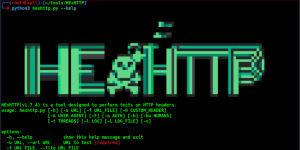Offensive Security Tool: Crypto Steganography

Reading Time: 4 Minutes
Offensive Security Tool: Crypto Steganography
Cryptosteganography
Steganography is the practice of concealing a message within another message or a physical object. In computing/electronic contexts, a computer file, message, image, or video is concealed within another file, message, image, or video. Can be used as part of advanced Phishing simulation techniques or concealing encrypted secret messages.
It is the art of concealing information within different types of media objects such as images or audio files, in such a way that no one, apart from the sender and intended recipient, suspects the existence of the message. By default steganography is a type of security through obscurity.
Cryptosteganography by Computationalcore is a python steganography module to store messages or files protected with AES-256 encryption inside an image.
Additionally this module also enhance the security of the steganography through data encryption. The data concealed is encrypted using AES 256 encryption, a popular algorithm used in symmetric key cryptography.
Prerequisites
(Most Linux systems comes with python 3 installed by default).
See Also: Recon Tool: WitnessMe
Dependencies Installation (Ubuntu)
$ sudo apt-get install python3-pip
Dependencies Installation (MacOS)
To install Python3 its recommended to use Homebrew package manager
The script will explain what changes it will make and prompt you before the installation begins.
$ ruby -e “$(curl -fsSL https://raw.githubusercontent.com/Homebrew/install/master/install)”
Edit your ~/.profile to include (if it is not already there)
export PATH=/usr/local/bin:/usr/local/sbin:$PATH
To install Python 3:
$ brew install python3
See Also: Apple pays out $100k bounty for Safari webcam hack that imperiled victims’ online accounts
Installation
To install the package just run
$ pip3 install cryptosteganography
See Also: Complete Offensive Security and Ethical Hacking Course
Usage
Use as a library in a python program
Store a message string inside an image
from cryptosteganography import CryptoSteganography
crypto_steganography = CryptoSteganography(‘My secret password key’)
# Save the encrypted file inside the image
crypto_steganography.hide(‘input_image_name.jpg’, ‘output_image_file.png’, ‘My secret message’)
secret = crypto_steganography.retrieve(‘output_image_file.png’)
print(secret)
# My secret message
Store a binary file inside an image
Note: This only works if the concealed file size is smaller than the input image
from cryptosteganography import CryptoSteganography
message = None
with open('sample.mp3', "rb") as f:
message = f.read()
crypto_steganography = CryptoSteganography('My secret password key')
# Save the encrypted file inside the image
crypto_steganography.hide('input_image_name.jpg', 'output_image_file.png', message)
# Retrieve the file ( the previous crypto_steganography instance could be used but I instantiate a brand new object
# with the same password key just to demonstrate that can it can be used to decrypt)
crypto_steganography = CryptoSteganography('My secret password key')
decrypted_bin = crypto_steganography.retrieve('output_image_file.png')
# Save the data to a new file
with open('decrypted_sample.mp3', 'wb') as f:
f.write(secret_bin)
Use as a python program
Check help at command line prompt to learn how to use it.
$ cryptosteganography -h
usage: cryptosteganography [-h] {save,retrieve} ...
A python steganography script that save/retrieve a text/file (AES 256
encrypted) inside an image.
positional arguments:
{save,retrieve} sub-command help
save save help
retrieve retrieve help
optional arguments:
-h, --help show this help message and exitSave sub command help
$ cryptosteganography save -h
usage: cryptosteganography save [-h] -i INPUT_IMAGE_FILE
(-m MESSAGE | -f MESSAGE_FILE) -o
OUTPUT_IMAGE_FILE
optional arguments:
-h, --help show this help message and exit
-i INPUT_IMAGE_FILE, --input INPUT_IMAGE_FILE
Input image file.
-m MESSAGE, --message MESSAGE
Your secret message to hide (non binary).
-f MESSAGE_FILE, --file MESSAGE_FILE
Your secret to hide (Text or any binary file).
-o OUTPUT_IMAGE_FILE, --output OUTPUT_IMAGE_FILE
Output image containing the secret.Retrieve sub command help
$ cryptosteganography retrieve -h
usage: cryptosteganography retrieve [-h] -i INPUT_IMAGE_FILE [-o RETRIEVED_FILE]
optional arguments:
-h, --help show this help message and exit
-i INPUT_IMAGE_FILE, --input INPUT_IMAGE_FILE
Input image file.
-o RETRIEVED_FILE, --output RETRIEVED_FILE
Output for the binary secret file (Text or any binary
file).Save message example
$ cryptosteganography save -i 4824157.png -m “My secret message…” -o output.png
Enter the key password:
Output image output.png saved with success
Retrieve message example
$ cryptosteganography retrieve -i output.png
Enter the key password:
My secret message…
Save file example
$ cryptosteganography save -i input_image_name.jpg -f duck_logo.pem -o output_file.png
Enter the key password:
Output image output_file.png saved with success
Retrieve file example
$ cryptosteganography retrieve -i output.png -o decrypted_file
Enter the key password:
decrypted_file saved with success
Limitations
- Only works with python 3
- It does not work if the conceived file is greater than original input file
- Output image is limited to PNG format only.
- The creator didn’t tested it with all conceived file types.









